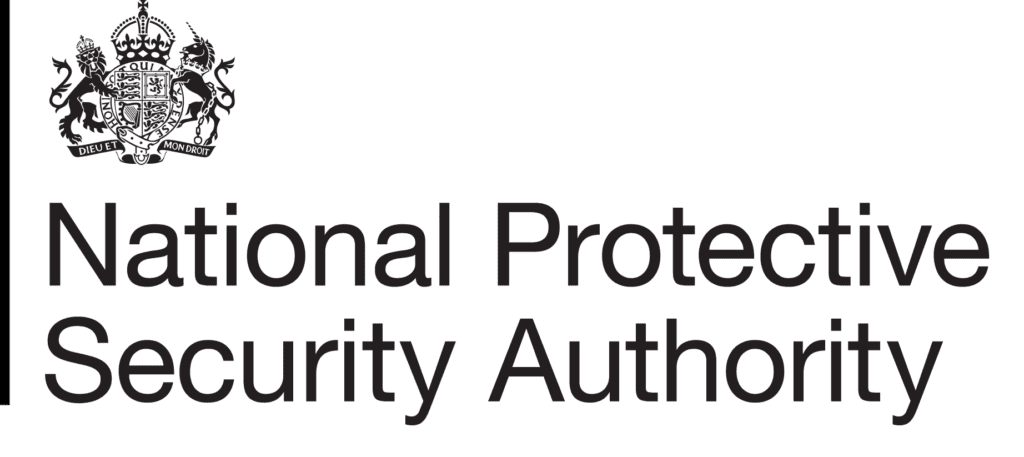The Security risk to the UK has never been higher. With the worldwide geopolitical situation in a heightened state and the national threat level at substantial, the UK’s need for good security has never been more important.
The government, which includes the National Technical Authorities and Industry, has joined together with The Security Institute to form the Trailblazer Group, and is proud to announce the Level 4 Protective Security Adviser Qualification and Apprenticeship.
Read on to find out more.





A security apprenticeship covering Physical Security, Personnel Security, Cyber Security and Technical Security.
The Government Security Board, with key industry partners, has developed the Level 4 Protective Security Adviser Qualificaton (outside England) and Apprenticeship (England) to commence in Autumn 2025.
If you are a user of security services — whether in physical, personnel, technical, or cyber security — the Protective Security Adviser Qualification and Apprenticeship may represent an excellent opportunity for you, your organisation, and your employees. It is designed to support capability development across the entire protective security profession, helping to build a workforce that is recognised, professionalised, and equipped to meet current and emerging threats.
Focuses on creating a safe and secure environment for staff, visitors, and assets by protecting against a broad range of threats, including theft, terrorism, and espionage. This may involve measures such as secure access control, surveillance systems, perimeter protection, and incident response planning.


Aims to ensure that individuals working in sensitive roles are appropriately vetted and trustworthy. It also helps to protect employees from undue influence or exploitation arising from their personal circumstances. Personnel security includes identity verification, security clearance processes, and ongoing monitoring where appropriate.
Involves safeguarding sensitive information and technologies against physical and technical threats. This includes protecting systems and infrastructure from close access acquisition, eavesdropping, interference, or exploitation by hostile actors. It often involves the integration of physical and digital protections.


Ensures the confidentiality, integrity, and availability of data and digital systems. This encompasses defending against cyber attacks, managing digital risk, securing networks and cloud services, and promoting secure-by-design principles across digital platforms.
The Level 4 Protective Security Adviser Qualification and Apprenticeship is designed to strengthen the UK’s protective security capability by reducing organisational vulnerabilities and overcoming siloed approaches to security. It supports both first-time entrants and career changers, offering a structured, progressive route into a professional career in protective security.
Developed with the full backing of the National Technical Authorities (NTAs), the qualification and apprenticeship promote security convergence by addressing critical gaps in knowledge, skills, and behaviours. This provides both individuals and organisations with a stronger, more resilient security baseline.
Structured in modular form, the programme begins with essential principles and develops towards more advanced competencies as learners progress.
Applications will open once the qualification and apprenticeship have been formally approved. At that point, training providers and The Security Institute will publish links to apply.
First, speak to the person in your organisation responsible for learning and development. Once you have their support, choose an approved training provider and follow their application process.
Yes. Applicants must have achieved Level 2 qualifications in English and Maths, or must obtain them before completing the end-point assessment.
Yes. Prior qualifications and relevant learning can be taken into account. Speak with your chosen provider to discuss recognition of prior learning (RPL).
No. The qualification and apprenticeship are open to anyone who meets the minimum entry criteria. It is expected to be most relevant to UK-based employees who currently work in — or wish to move into — a protective security role, including those considering a second career.
No for the apprenticeship: you must have the support of a sponsoring employer to undertake it. However, for the qualification, you may be able to undertake it on an individual basis.
No. Apprenticeships are open to anyone over the age of 16, regardless of age. They provide life-long skills and career progression opportunities.
Absolutely. There is no upper age limit for apprenticeships.
No. You can start an apprenticeship if you:
Are aged 16 or over
Are not in full-time education
Live in England (with the Qualification available in Scotland, Wales and Northern Ireland)
Already have previous qualifications, including degrees
Yes, provided you meet the entry requirements, your employer supports your application, and appropriate funding is available.
Not unless your current role requires it. Clearance is not a general prerequisite for enrolment.
Finalised costs will be published on provider websites once confirmed. The programme is expected to fall within the scope of the apprenticeship levy.
Not for the apprenticeship; Employers can use their apprenticeship levy funding to cover the costs.
This will depend on your employer and training provider. While most learners will be employer-sponsored, you should discuss funding arrangements directly with your employer.
Yes. You will remain employed and be paid by your employer. Pay rates vary — some employers continue to pay existing salaries, while others may use apprenticeship pay bands. Check current rates here.
Approved training providers will deliver the qualification and apprenticeship. These providers are accredited by the National Technical Authorities (NTAs) to ensure the training meets the required standards.
Yes. Most delivery will be a combination of classroom-based and online learning, alongside on-the-job training. The balance is typically 20% off-the-job learning and 80% in-role application.
Training providers will operate across the UK to ensure broad access. In some cases, apprentices may need to travel to a local provider. Travel and accommodation costs are not covered as part of the programme but may be reimbursed by your employer.
Yes. The programme is structured around four core pillars:
Physical Security
Personnel Security
Technical Security
Cyber Security
These modules are designed to integrate and promote a holistic understanding of protective security.
Yes. In fact, applying what you learn in your workplace is an essential part of the qualification and apprenticeship.
The qualification and apprenticeship have been developed with the full support of government, industry, and the National Technical Authorities.
You will need to agree time off with your employer and, where necessary, your training provider. Module dates will be shared in advance to support planning. It is advisable to avoid extended leave outside of standard academic breaks.
It is a modular, structured programme typically completed alongside your job role.
The qualification and apprenticeship are expected to take 12 to 18 months to complete, depending on individual progress and circumstances.
You will achieve a Level 4 Protective Security Adviser Qualification or Apprenticeship, equivalent to a foundation degree, recognised by the National Technical Authorities.
Graduates may pursue a variety of roles in protective security, including:
Security Risk Manager
Personnel Security Adviser
Technical Security Specialist
Cyber Security Practitioner
Protective Security Consultant
Yes. The qualification and apprenticeship can support your transition into a civilian security career and provide recognised skills and accreditation.
Yes. This programme is ideal for individuals looking to move into the security profession with structured training and employer support.
You should already be employed to begin the apprenticeship programme. The qualification and apprenticeship will enhance your capabilities and may support career progression or open new opportunities within your organisation. It may also help your employer meet upcoming contractual requirements for qualified security professionals.
From 2026, government contracts in protective security will require staff to hold recognised qualifications. Supporting employees through this programme will help organisations meet those requirements and demonstrate professional competence in security delivery.